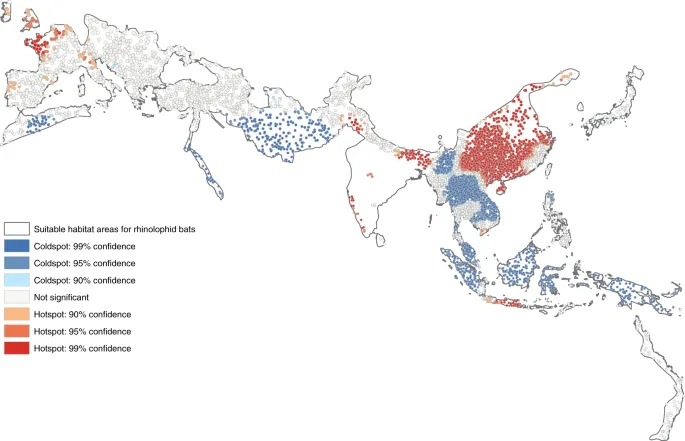China has attempted to expand forests on a large scale, planting many of these trees in places where forests have been destroyed
Where in the world the new coronavirus can be born, scientists have found out. Large-scale land-use changes are occurring around the world, including changes in forests, agricultural expansion, and cattle production. These are creating favorable ‘hot spots’ for bats that can carry the coronavirus and where the disease can spread from bats to humans.
An analysis by researchers from the University of California, Berkeley, Politecnico di Milano and Massey University in New Zealand, which is published in the international journal Nature Food. However, if we talk about the origin of coronavirus SARS-CoV-2, then this puzzle is still unsolved. The only thing we know about this is that the virus, which can infect the horseshoe bat, was either directly transmitted to humans by bats or with the help of other animals such as pangolins.
If we talk about the horseshoe bat, this bat can carry many types of coronaviruses, including many viruses that are genetically similar to the coronaviruses that cause Covid-19 and SARS.

Researcher Paolo D’Odorico, associated with this research, said that changes in land use can have health effects, because we are changing the environment, due to which these zoonotic diseases can increase the risk to health.
The new research used remote sensing to analyze the land use of areas where horseshoe bats are found. This region extends from Western Europe to Southeast Asia. The researchers identified changes in forests, agricultural expansion, and cattle areas at these locations and compared them with the habitat of this horseshoe bat. With the help of this, they have identified potential ‘hot spots’ places that these bats are conducive to live.
The analysis also identified locations that could become easily become hot spots with changes in land use.
Land-use changes can have an important impact on human health, both because we are modifying the environment, but also because they can increase our exposure to zoonotic disease.”
Paolo D’Odorico, Study Co-Author and Professor, Environmental Science, Policy and Management, UC Berkeley
According to the research, most of these hotspots are in China, where increasing demand for meat products has driven the expansion of cattle rearing on a large-scale industrial scale. The researchers said that large-scale rearing of cattle makes this place a hotspot for spreading diseases because these animals are genetically similar, their immunity is so weak in which this virus can easily spread.

Along with this, the analysis also found that parts of Japan, the northern Philippines, and Shanghai in the south of China could become future hotspots, where changes being made in forests could help it to spread. At the same time, due to increasing livestock production in parts of India, China, and Thailand, this area can become a hotspot for infection in the future.
“The purpose of the analysis is to identify the potential emergence of new hot spots in response to an increase in one of three land use characteristics, highlighting both areas that may be suitable for spillover and the types of land use changes that may lead to hot spot activation.” can motivate,” said study co-author Maria Cristina Rulli, professor in hydrology and water and food security at the Politecnico di Milano in Italy.
Human encroachment into the natural habitat may also indirectly increase the risk of zoonotic disease by reducing valuable biodiversity. When forest land is fragmented and natural habitats are destroyed, species that require very specific habitats to survive, called “specialists”, may decline or even become extinct. Without competition from specialists, “generalists” species, who are less picky about their habitat, can take over.

The average values of these statistics are then calculated for China and the other regions of the world with habitat suitable for Rhinolophidae and compared and the difference is tested for significance using the Mann–Whitney non-parametric test in Mathematica.
Human encroachment into the natural habitat may also indirectly increase the risk of zoonotic disease by reducing valuable biodiversity. When forest land is fragmented and natural habitats are destroyed, species that require very specific habitats to survive, called “specialists”, may decline or even become extinct. Without competition from specialists, “generalists” species, who are less picky about their habitat, can take over.
Over the past two decades, China has attempted to expand forests on a large scale, planting many of these trees in places where forests have been destroyed. But it has to be noted that rather than increasing the total tree cover, it is more important to restore the habitat of these specific species and restore the forests as before.
The horseshoe bat is a generalist species and has been frequently observed in areas with human disturbance. Earlier work by Rulli, D’Odorico and study co-author David Heyman has also linked forest fragmentation and habitat destruction to Ebola virus outbreaks in Africa.
“By creating conditions that are harmful to specialist species, generalist species are able to thrive,” D’Odorico said. “While we are unable to directly trace the transmission of SARS-CoV-2 from wildlife to humans, we do know that the type of land use change that brings humans into the picture is usually associated with the presence of these bats known as Known to carry the virus.”
Support us to keep independent environmental journalism alive in India.
Keep Reading
The costliest water from Narmada is putting a financial burden on Indore
Indore’s Ramsar site Sirpur has an STP constructed almost on the lake
Indore Reviving Historic Lakes to Combat Water Crisis, Hurdles Remain
Indore’s residential society saves Rs 5 lakh a month, through rainwater harvesting
Follow Ground Report on X, Instagram and Facebook for environmental and underreported stories from the margins. Give us feedback on our email id greport2018@gmail.com.
Don’t forget to Subscribe to our weekly newsletter, Join our community on WhatsApp, and Follow our YouTube Channel for video stories.









